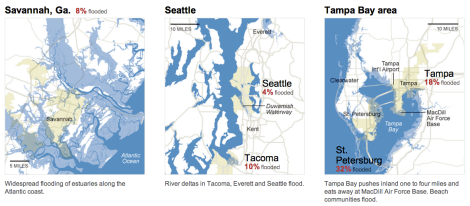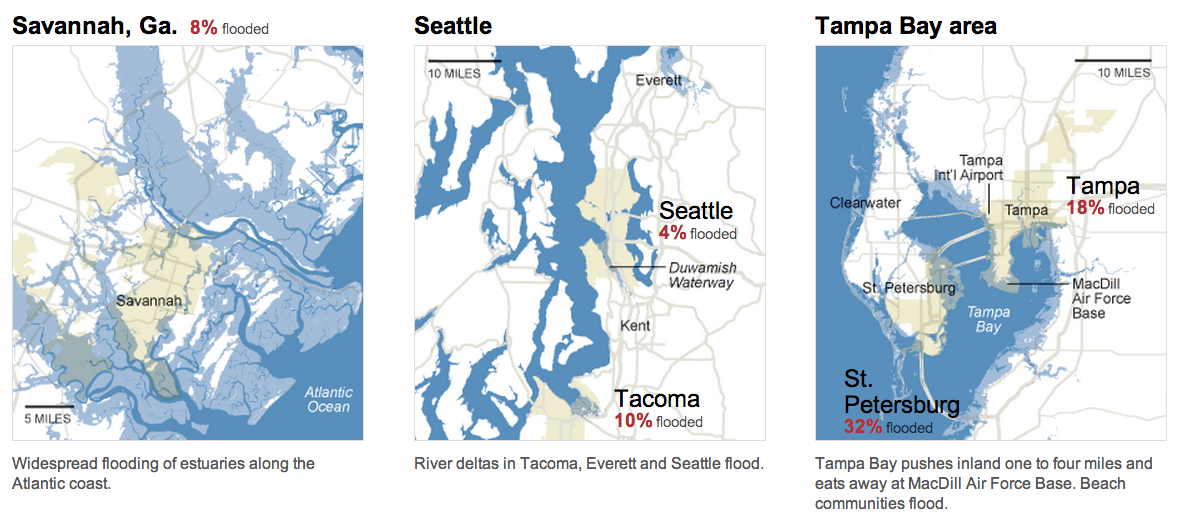Earlier today, the office of New York City Mayor Michael Bloomberg announced the anticipated economic impact of superstorm Sandy.
We estimate total losses to NYC from #Sandy to be $19billion. We’re asking fed govt for $9.8billion for costs not covered by insurance/FEMA.
— NYC Mayor’s Office (@NYCMayorsOffice) November 26, 2012
Disaster cleanup is a lousy way to spend $19 billion, even if it creates thousands of temporary jobs. A much better way is to spend money to prevent the worst effects from happening at all. So far, Americans have shown little interest in such foresight. From The New Yorker’s James Surowiecki:
[F]or the most part, the U.S. has shown a marked bias toward relieving victims of disaster, while underinvesting in prevention. A study by the economist Andrew Healy and the political scientist Neil Malhotra showed that, between 1985 and 2004, the government spent annually, on average, fifteen times as much on disaster relief as on preparedness.
Politically speaking, it’s always easier to shell out money for a disaster that has already happened, with clearly identifiable victims, than to invest money in protecting against something that may or may not happen in the future. Healy and Malhotra found that voters reward politicians for spending money on post-disaster cleanup, but not for investing in disaster prevention, and it’s only natural that politicians respond to this incentive.
Surowiecki notes another political roadblock: the federal government’s ongoing indifference to broad infrastructure spending. Combine the two, and the prospect of preventative investment seems daunting.
[protected-iframe id=”6963076a2661797a78d425c2b03f3d3f-5104299-30178935″ info=”http://project.wnyc.org/flooding-sandy-new/index.html” width=”470″ height=”400″]
Map of post-Sandy flooding.
The problem isn’t only in New York City. Yesterday, The New York Times shared a series of maps outlining how rising sea levels threaten millions of Americans on both coasts.

New York TimesExpected inundation for three cities with a five-foot sea-level rise.
The same question applies for each of these cities: Can and will investment be made to protect them from higher seas? The Times had an op-ed accompanying the maps that addressed the question.
This past summer, a disconcerting new scientific study by the climate scientist Michiel Schaeffer and colleagues — published in the journal Nature Climate Change — suggested that no matter how quickly we cut this pollution, we are unlikely to keep the seas from climbing less than five feet.
More than six million Americans live on land less than five feet above the local high tide. (Searchable maps and analyses are available at SurgingSeas.org for every low-lying coastal community in the contiguous United States.) Worse, rising seas raise the launching pad for storm surge, the thick wall of water that the wind can drive ahead of a storm. In a world with oceans that are five feet higher, our calculations show that New York City would average one flood as high as Hurricane Sandy’s about every 15 years, even without accounting for the stronger storms and bigger surges that are likely to result from warming. …
We hope that with enough time, most of our great coastal cities and regions will be able to prepare for a five-foot increase. Some will not. Barriers that might work in Manhattan would be futile in South Florida, where water would pass underneath them by pushing through porous bedrock.
According to Dr. Schaeffer’s study, immediate and extreme pollution cuts — measures well beyond any discussion now under way — could limit sea level rise to five feet over 300 years. If we stay on our current path, the oceans could rise five feet by the first half of next century, then continue rising even faster.
The conclusion of the piece: “There are two basic ways to protect ourselves from sea level rise: reduce it by cutting pollution, or prepare for it by defense and retreat. To do the job, we must do both.”
Increasingly, it seems as though we’re willing to do neither. Part of the reason for that was made very clear in at least some editions of the Times.
Defining irony as the layout of the NYT Sunday Review section. twitter.com/matthewstoller…
— Matt Stoller (@matthewstoller) November 25, 2012
Shell made $31 billion in profits last year, meaning it could pay for the entirety of the damage New York City took from megastorm Sandy and still be able to spend $380 a second. Shell spends money freely — as with that Times ad, as with its $10.8 million in lobbying this year — for its own protection. And part of protecting itself means opposing efforts to reduce carbon dioxide pollution. It means, in effect, protecting itself at our collective expense.
As our unwillingness to support the tough politics of prevention show, we may be our own worst enemies. But hyper-rich fossil fuel companies aren’t exactly our allies.



